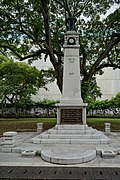Embassy of the United Kingdom, Bangkok

The Embassy of the United Kingdom in Bangkok is the chief diplomatic mission of the United Kingdom in Thailand. Established as an embassy in 1947, its history dates to 1856 when a British consul was first posted in Bangkok following the signing of the Bowring Treaty. First established on Charoen Krung Road by the Chao Phraya River, the mission relocated to a new site on the corner of Phloen Chit and Witthayu Roads in 1922. Originally a rural location on the outskirts of the city, the area soon developed into one of the city centre's prime locations. The compound remained a leafy oasis amidst its densely developed surroundings throughout the 20th century, but was sold to Central Group at record-setting prices, first partially in 2007, then completely in 2017. The embassy is now based in an office building on Sathon Road, while its original buildings, including the ambassador's residence, have been demolished to make way for redevelopment.
History
Establishment


In 1856, following the coming into force of the Bowring Treaty, Charles Batten Hillier became the first British Consul in Bangkok. The mission originally rented premises in the area of
The consulate was raised to the status of a
Move to Phloen Chit
When Minister
The legation was re-established as the British Embassy in 1947, with Geoffrey Harrington Thompson becoming the first British Ambassador to Thailand.[2] Several additional buildings have since been built, but the compound remained an oasis of greenery amidst its surroundings, which by the late 20th century had developed into part of the commercial city centre, containing luxury hotels, offices, apartments and shopping malls.[5]
Redevelopment and sale

In 2006, as part of its plan to downgrade several embassies and consulates to divert funds to other activities, the British
In 2017, the Foreign Office sold the remaining 23 rai (3.7 ha; 9.1 acres) of embassy land. The auction was again won by Central Group, who reportedly offered in the range of 2–2.2 million baht per
Features
- Embassy building/ambassador's residence
- The main building of the embassy, built during the years 1923–1926, was a two-storey building in British colonial style.
- Queen Victoria statue
- The statue of Queen Victoria is a copy from the same mould of the statue at Winchester designed by Sir Alfred Gilbert for the Queen's golden jubilee.[12] The plinth bears the inscription, "Victoria, Queen of Great Britain & Ireland, Empress of India. Erected in loving memory by her subjects in Siam. 1903." Originally situated outside the entrance gates to the legation on Charoen Krung Road, it was subsequently moved when the mission relocated to the new compound and again when part of the site was sold in 2007. The statue was boarded up when the consulate was occupied by the Japanese during World War II, but a peephole was left, symbolically allowing the Queen to see outside. The statue also used to be popular with local Thais, who would leave offerings in exchange for good fortune, help in exams, or success in bearing children.[2][14]
- War memorial
- The war memorial, dedicated on 10 October 1922, was the first structure to be raised at the new Phloen Chit site. It is made of granite and was designed by the sculptor Sir James Taggart.[12] Originally located behind the entrance gates, it was also moved to the front of the ambassador's residence in 2007.[15] Following the sale of the embassy, the memorial was relocated to the British Club.
Gallery
-
The Ambassador's Residence (rear façade)
-
Queen Victoria statue
-
War memorial
See also
References
- ^ ธโนทัย สุขทิศ (6 October 2020) [July 2006]. "แผ่นดินทองที่ไม่ใช่ของไทย : ที่ดินสถานทูตอังกฤษ". Silpa Wattanatham (in Thai). Retrieved 8 January 2021.
- ^ a b c d e "History Of The Embassy British Embassy, Bangkok". British Embassy, Bangkok website. Archived from the original on 24 February 2008. Retrieved 18 June 2017.
- ^ "Siam". Straits Echo. 24 March 1905. p. 5. Retrieved 2022-10-17 – via newspaperSG.
- ^ "Queen Victoria Memorial in Bangkok". Straits Echo. 3 April 1905. p. 2. Retrieved 2022-10-17 – via newspaperSG.
- ^ a b Berger, Sebastien (9 February 2005). "Britain to sell off its prime acres in Thailand". The Telegraph. Retrieved 18 June 2017.
- ^ "UK ambassador confirms plans to sell British Embassy land – The Nation". The Nation. 29 March 2017. Archived from the original on 8 June 2019. Retrieved 18 June 2017.
- ^ "คาดเซ็นทรัลคว้าที่ดินสถานทูตอังกฤษ 25 ไร่ 2 หมื่นล้านบาท". Post Today (in Thai). 15 February 2017. Retrieved 21 June 2017.
- ^ Foreign and Commonwealth Office (31 January 2018). "British Embassy Bangkok moves to a new home for the 21st century - GOV.UK" (Press release). Retrieved 2 February 2018.
- ^ Rudgard, Olivia (31 January 2018). "Queen Victoria statue in Bangkok lost to the nation after embassy moves to office block". The Telegraph. Retrieved 2 February 2018.
- ^ Brewis, Harriet (13 August 2019). "Britain's historic Bangkok embassy bulldozed 'to make way for mall'". Evening Standard. Retrieved 23 August 2019.
- ISBN 9786167384061.
- ^ a b c Bertram, Mark (31 January 2016). "Bangkok: before 1926". Room for Diplomacy. Retrieved 21 June 2017.
- ^ "UK government asked to return conservation award for demolition of former embassy building". Thai PBS World. 24 August 2019. Retrieved 6 February 2021.
- ^ Barrow, Richard (21 December 2012). "Queen Victoria's Statue at the British Embassy in Bangkok". richardbarrow.com. Retrieved 21 June 2017.
- ^ "The Embassy Compound Redevelopment". British Embassy, Bangkok website. British Embassy, Bangkok. 1 March 2007. Archived from the original on 1 March 2007. Retrieved 26 June 2017.



